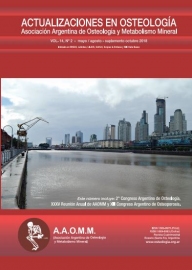De la osteología a la osteomiología: tres décadas de aportes originales continuos al análisis biomecánico osteomuscular
Autores: José L. Ferretti, Gustavo R. Cointry, Ricardo F. Capozza
Resumen
En consonancia con la orientación tra¬dicional de nuestras investigaciones, la Os¬teología está incorporando progresivamente el análisis estructural-biomecánico óseo y las interacciones músculo-esqueléticas. En este artículo se sintetizan los aportes origi¬nales del CEMFoC a la Osteología moderna en el terreno biomecánico en forma didácti¬ca, para que el lector aprecie sus posibles aplicaciones clínicas. Los hallazgos aporta¬ron evidencias sucesivas en apoyo de dos proposiciones fundamentales: a) los huesos deben interpretarse como estructuras resis-tivas, biológicamente servocontroladas (Los huesos tienden siempre a mantener un factor de seguridad que permite al cuerpo trabajar normalmente sin fracturarse Paradigma de Utah) y b) los huesos interactúan con su entorno mecánico, determinado principal¬mente por las contracciones musculares, en forma subordinada al entorno metabólico (Los huesos son lo que los músculos quie¬ren que sean, siempre que las hormonas lo permitan). Los avances producidos se refie¬ren, tanto cronológica como didácticamen¬te, al conocimiento osteológico en general y al desarrollo de recursos novedosos para el diagnóstico no invasivo de fragilidad ósea, para distinguir entre osteopenias y osteopo¬rosis, y para discriminar entre sus etiologías mecánica y sistémica. Finalmente, el nue¬vo conocimiento se integra en la proposición de un algoritmo diagnóstico para osteope¬nias y osteoporosis. El espíritu general de la presentación destaca que la evaluación osteomuscular dinámicamente integrada ge¬nera un nuevo espacio de análisis persona¬lizado de los pacientes para la atención de cualquier osteopatía fragilizante con criterio biomecánico.
Palabras clave: biomecánica ósea, osteope¬nia, osteoporosis, densitometría ósea, tomo¬grafía ósea, relaciones hueso/músculo, sarco¬penia, dinamometría.






